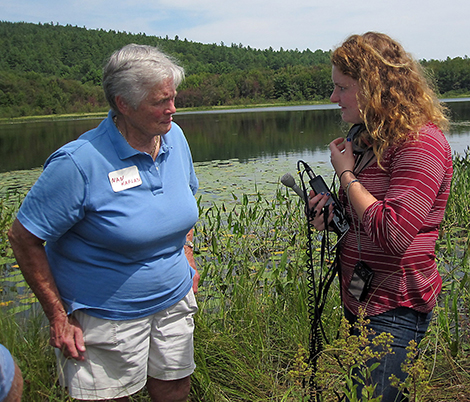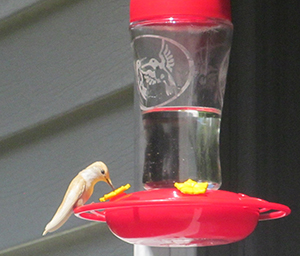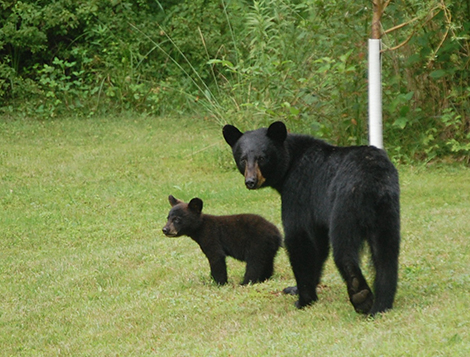
In the United States, we have four categories of wetlands: marshes, bogs, fens, and swamps. A bog is a freshwater wetland characterized by deposits of acidic peat, the result of slowly decomposing vegetation, particularly sphagnum moss. All or most of a bog’s water comes from precipitation, and the dissolved tannins from plant matter give it a tan color. Although bogs provide important benefits, many of them have been drained in the past and converted for agricultural, commercial, or residential use: a big mistake.
To help citizens and landowners understand the importance of bogs, the Andover Conservation Commission (ACC) organized a bog “talk and walk” as part of its Taking Action for Wildlife series. ACC member Nan Kaplan reports that about 30 people gathered in mid-August for a presentation by ecologist Emma Carcagno, Wildlife Program Assistant at UNH. Thanks to Greg Hamel, owner of the Blackwater Junction Restaurant, the group was able to meet indoors for a slide show and lecture before heading out to explore Bog Pond on the Blackwater River in Cilleyville.
Participants learned that bogs are important as a prevention against downstream flooding through their ability to absorb precipitation. During their walk, the group observed that bogs provide crucial habitat for plants such as sundews, pitcher plants, sphagnum moss, and leatherleaf, as well as for crustaceans, amphibians, and fish. Moose and beavers are among the mammals that live and eat in bogs. Plus, we all depend on bogs to help maintain the global climate by storing large amounts of carbon.
During the walk, Andover resident Skip Powers shared some recollections of his time at Bog Pond. As a young man, he fished and trapped in the area, pointing out that a good muskrat pelt would sell for as much as $5 back then.
You can see photographs and hear more from Ms. Carcagno and Skip Powers by listening to the audio postcard by NHPR reporter Abby Kessler at TinyURL.com/Andover-Bog-Walk.

I talked with Skip Powers later and learned that he began his life in a house just west of Bog Pond, and now he and his wife Edie live just east of Bog Pond. Their property hugs the side of Ragged Mountain, and they appreciate the wildlife they see there regularly.
Skip and Edie showed me pictures they took of a pair of young grey foxes climbing trees in their yard. Skip learned from Ron Evans that grey foxes have claws like house cats that make it easy to climb trees, but difficult to come back down!
Recently, Edie was surprised by what she saw at their hummingbird feeder, calling to Skip, “There’s a white hummingbird at the feeder!” He didn’t believe her until he saw it himself. Their son David got online and talked to some experts, and they agreed that it’s not an albino, because its eyes aren’t pink. It is a “color morph,” a rare but naturally-occurring color variation of a regular hummingbird. You can learn more about color morphs at ProjectNoah.org/missions/7970027.
Bears
Edie and Skip also see bears in their yard frequently, and many of you Beacon readers have sent in pictures of bears at your houses. While it can be thrilling to see these wild animals up close, their visits can also bring trouble. As bear expert Ben Kilham writes, “Nothing good ever happens when people with food invite bears to approach their house.”

We still have a month or so of bear season before cold weather forces them into hibernation, so residents may want to heed the warning of the New Hampshire Fish and Game Department: “If a bear is active in your community, you should cease and desist all bird feeding activities.” They recommend removing bird feeders during bear season or bear-proofing those feeders.
Bears looking for food will find your bird seed, pet food, garbage cans, and barbecue grills if they aren’t stored indoors or otherwise secured. When bears become dependent on human food, they sometimes develop into a dangerous nuisance. You can learn more at BearSmart.com, an organization whose goal is to minimize the number of bears killed as a result of human-caused problems.
Please remember to send me your observations, photographs, and questions at AndoverNaturally@nullgmail.com.